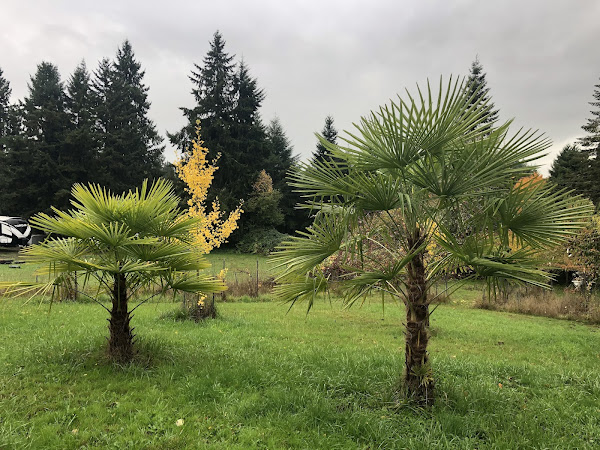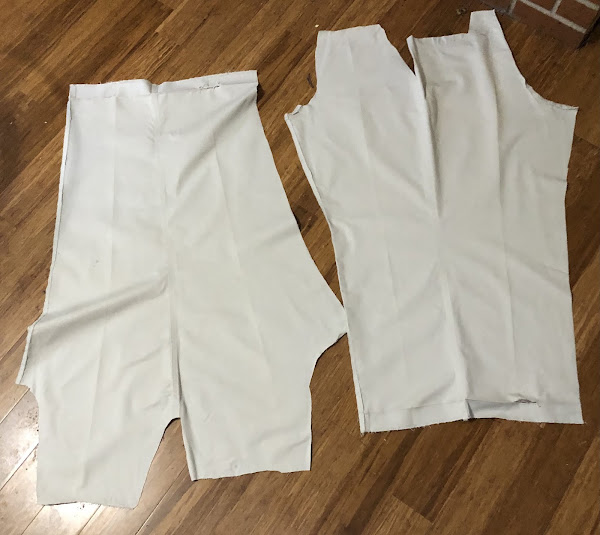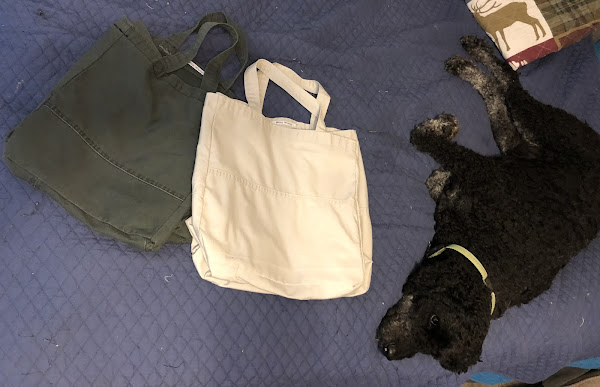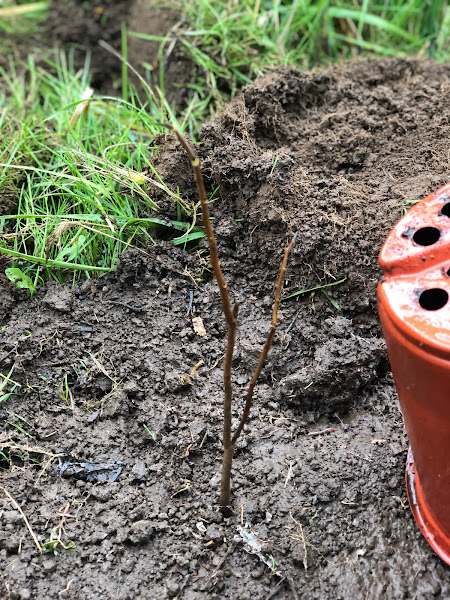Tuesday, October 26, 2021
Persimmon Trees. 10.26.2021
Gingko Trees. 10.26.21
Sunday, October 24, 2021
A Reversable, Chino / Flannel Cadet Cap. 20.24.2021
There were a few left over pieces of chino, after I made a grocery tote out of Ning's old trousers. As posted before, I like wearing cadet caps. Without that protection, I bump my head regularly, leaving divets and scabs on my scalp, which I don't like. I use an old, disassembled cadet cap for the pattern. However, I add 1/4 inch to each dinension for better fit. Chino fabric is perfect weight and comfort. This time, I used scraps of flannel for a lining, quilted the top part for scalp padding, and made it reversable.
Laying out the remaining trouser parts and patterns. Will it work? Note, I didn't wind up making the unnecessary hat band.
This time, I added more stiffness to the brim, using medium weight fusable woven interfacing in addition to the thick foamy interfacing I usually use. For the lining, I used exactly the same pattern as the shell. It will shrink just a little, I think. The sides are stiffened a little too with a medium weight, nonwoven fusable interfacing. Then the hat is sewn together inside out, with a big gap at the back. I had to hand baste the brim, which points inward at this point. It's too difficult to pin or clamp the stiff, awkward, thick three-part sections, but hand basting actually works. Then turn right side out and sew the rest together. I hand basted that together too. The cap came out pretty decent. I think it's the best made of my attempts, so far. The chino fabric, with interfacing, is the perfect stiffness / warmth / comfort. The added interfacing makes the brim stiff enough to hold its shape, without being a herd piece of plastic. I like it better without the hat band. This brim came out better too. I used an edge hem to hold its shape, and drew the lines on the fabric before sewing, using a washable fabric pen. That helped a lot.
A Couple of Fall Chores. 10.24.21
This was between rains. I had some bulbs to plant, and some ashes to spread.
Most of the garden now is clean-up from the year's crops and flowers, with thoughts for prep for next year.
So far my thoughts for next year, building on experience especially from 2021-
Raised Beds.
The taller raised beds made a significant difference. For the accessible garden, less difficult, more production in a small space, I was very happy with the three beds I installed last year. They grew the best, and most, garlic, onions, peppers, and bush beans that I've even grown. The crops of radishes, lettuce, spinach were also great. Imdid crowd them too much. And they were doable. They were much easier than ground-level gardening - less kneeling, less bending, easier cultivation and weeding. One was undermined by moles and two sides fell over. That will need taking apart and rebuilding during the winter, with better screening underneath.
For 2022:
(1) Repair the damaged raised bid. Moderately big project. I need to build the new ones so there is a place to put the soil so I gan dig this one out and put down a mole barrier.
(2) Build two new, fairly long raised beds where I grew tomatoes this year. There is a little more clearing to do. I'll order materials and build them gradually during the winter. One day at a time, Beijing wasn't built in a day. I have all winter but want to get them done sooner so the soil will settle before planting.
(3) For 2022 I will grow less of a tomato crop. More of it will be dwarf size plants, which will be more suitable for the taller raised beds.
Irrigation.
This was a learning process. For the tomatoes, I used 1 gallon per hour drip emitters. For the raised beds, I used oozing hoses. The drip emitters worked quite well. I was able to turn on the water lines, go away, come back in an hour and turn off. I don't think they were a gallon in an hour. Probably a couple of quarts.
The oozing hoses were more challenging. The lines clogged up from the sediment from our well. I did put in an in-line filter but too late. The oozing stopped entirely. So, I used a safety pin to punch many holes in the hose, converting it to a mini sprinkler system. That actually worked pretty well. This was better for row crops, compared to the emitters that were better for individual plants.
I hand watered the squashes and sweetcorn. That was a lot of work. The squashes were saved partly by black plastic mulch. I used buckets to deliver two gallons to each hill of squash, daily during hot weather.
For 2022:
(1) The tomatoes will be in raised beds, so I need to remove the existing drip irrigation lines and re-install them in the raised beds. I'll use the same emitters and possible the punched ooze hoses if they still work. I'll put down brown paper mulch for Romas which are spreaders, and possibly for the dwarf tomatoes too.
(2) For squashes, use black plastic again but add the 1-gallon per hour emitters for them too. That's at least 1/2 of my bucket carrying for the summer. For the sweetcorn, I'm not sure. Maybe I'll use a sprinkler when it's small, like I did this year, and a thicker oozing hose or other row-friendly system. That's another big portion of he hand watering.
I'll address individual crops in more detail later.
Meanwhile, I shovel-turned about 40% of next hear's potato bed in between rains. Before doing so, I spread gallon bucket of wood-stove ashes over the roughly 200 square foot area. The ashes add calcium, phosphorus, potassium and some other minerals, and reduce the pH just a little. I also use chicken bones from my dog food manufacturing. I air dry the chicken bones, and store in a plastic bag. Then, when using the wood-stove, I throw a handful into each wood-fire until they are gone. The burning reduces them to powder and a small amount of very fragile pieces that break down rapidly in the soil. Bone ash also adds calcium, phosphorus, and a few minerals, and nothing bad. Potatoes shouldn't get lime the same year as they are grown, and ashes are a bit like lime but with more minerals. However, it's about six months of mostly rain before growing potatoes and this is a relatively small amount. So I think it's good.
I also planted some tulip and daffodil bulbs for Spring inspiration. The daffodils went into borders around the vegetable garden yard. The tulips went into one of the larger tomato containers, where they should be safe from deer browsing. Deer don't eat daffodils so they will be ok.Friday, October 22, 2021
Making Jalapeño Green Hot Sauce. 10.22.2021
Tabletop Quilt. 10.22.2021
Thursday, October 21, 2021
Nerine Flowers. 10.21.21
These Nerine were in a container for years, then two years ago I planted them in my garden in an out of the way location. Beyond weeding and a mulch, I don't do anything for them. My great aunt Emma used to grow Lycoris, which is very similar. She called them "Magic Lilies" because the leaves would die down, then weeks later a flower stalk would emerge. I've never been able to grow Lycoris here, but this Nerine seems quite happy.
Carnivorous Sarracenia Plants. 10.20.21
Some of the pitcher plants have a lot of nice color now. All I did with them this year was repot in larger containers and keep the rain water in their basins fresh to avoid mosquitoes / not dry out. During the winter they can just sit outside. It's a lot of color to be so easy.
Wednesday, October 20, 2021
Cooking a Jumbo Size "Illinois" Squash. 10.20.2021
Sewing Upcycled Chinos Grocery Totes. 10.29.2021
Planning a Table Top Quilt for Fall. 10.20.2021
Planting an Apple Seedling from Calypso™ X Golden Sentinel™
Last year I pollinated some Redlove™ Calypso™ blossoms with pollen from a Golden Sentinel apple tree. The goal was to see if seedlings would have red flesh apple traits but columnar shape tree. From the seedlings, twomhad red leaves, so I'm confident the apples will have red flesh. Both might have columnar shape. It's too early to say. This one has not made branchlets yet, unlike the other two. It does appear to have a blossom spur, even though it seems early for that.















































 t
t



